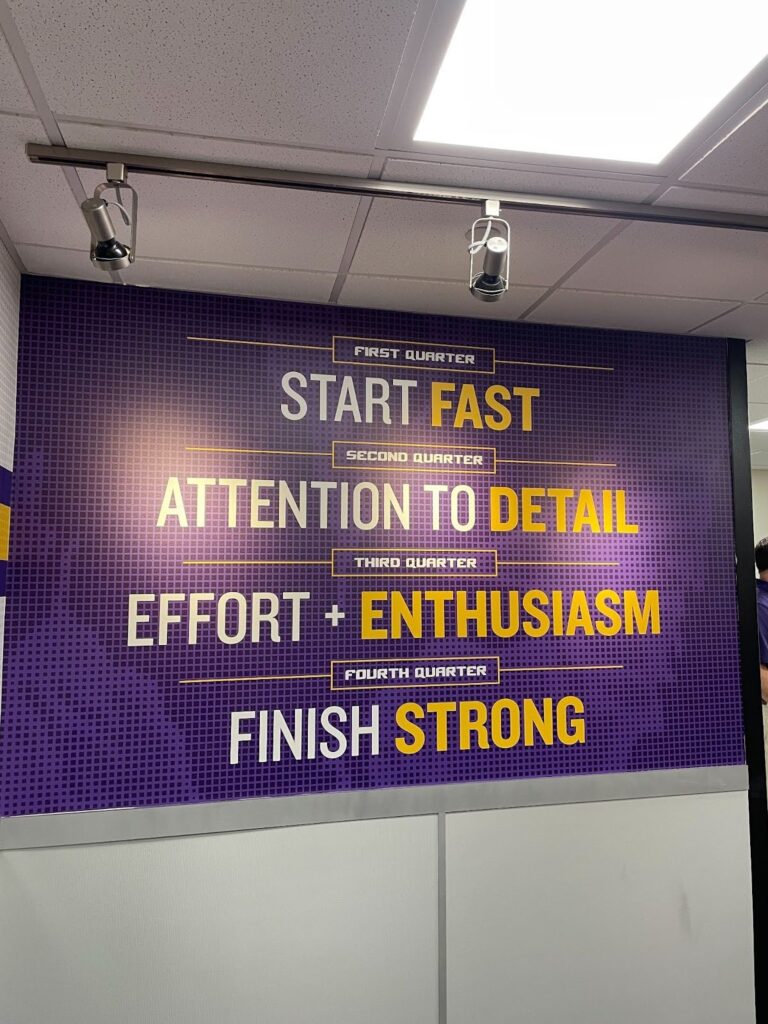How to set boundaries
LISTEN IN APPLE PODCASTS | LISTEN IN SPOTIFY | LISTEN IN STITCHER

My dad is a huge LSU football fan. Even though he didn’t attend LSU for college like I did, he’s bled purple and gold for as long as I can remember.
So a few years ago for his 60th birthday, I surprised him with a behind the scenes tour of Tiger Stadium. We’re talking a tour of the state of the Tiger’s state of the art football locker room, a photo op behind the press conference podium, a close up look at some of the most impressive awards in College Football and some time down on the field to see Death Valley, as it’s called, from the perspective of players and coaches as they emerge from the locker room. It was such a cool experience, and I’m so glad we were able to make it happen.
But even though there were some incredibly memorable moments, like seeing my husband Scott hold both of my girls on his shoulders so they could slap the legendary “Win” bar mounted over the door to the field, I’ll never forget something I saw painted on one of the hallway walls. It said:
First Quarter: Start Fast.
Second Quarter: Attention to Detail.
Third Quarter: Effort + Enthusiasm
Fourth Quarter: Finish Strong.

And it really stuck with me, because this is so similar to how we can show up successfully throughout the year.
But one really important part was missing from this equation.
And that’s halftime.
Halftime might not be played on the field, unless you’re a member of the band or the dance team – but halftime is absolutely critical to the success of the rest of the game.
Halftime is the team’s opportunity to look back on the first half of the game, celebrate amazing plays and acknowledge mistakes. It’s a time to rest, reassess and get realigned and ready for the rest of the game.
We might not be members of a football team, but we need halftime, too. We need time to intentionally look, look around and look ahead. But it’s really easy to skip a mid-year planning session because it’s not on the field. Sometimes it doesn’t feel productive to stop and plan, when you could be doing more things. That’s why this episode is dedicated to three big reasons why you shouldn’t skip mid-year planning and why you definitely need your own halftime to rest, reassess, realign and get ready to finish the year strong.
So today, we’re talking about
- How mid-year planning can transform your time management
- The secrets to boosting your productivity in the second half of the year
- Why revisiting your goals is essential for success
- How to achieve better work/life balance through planning
Let’s dive right into the first reason why you shouldn’t skip mid-year planning. And it’s because mid-year planning can transform your time management.
Why Mid-Year Planning is Crucial for Time Management
Y’all already know that time is our most valuable resource, right? We all get the same 24 hours in a day, but how we use those hours can really change everything. That’s why taking a moment to pause mid-year and reassess how things have been going can be a game-changer for time management.
Think about it like this: It’s July, and you realize that some of the goals you set back in January might not be all that relevant anymore. Maybe you’ve hit some of them out of the park, or maybe some have fallen by the wayside. Without a mid-year check-in, you might keep pushing towards goals that don’t really fit your life anymore. But with a mid-year planning session, you can hit the pause button, reassess your priorities, and realign your efforts with what’s most important right now.
Reassessing Priorities
It’s kind of like a GPS rerouting you when there’s traffic ahead. Your goals and priorities in January might look very different from your goals and priorities in July. Life happens, right? Maybe you’ve taken on new responsibilities at work, or perhaps your family dynamics have shifted. Whatever the case, a mid-year planning session gives you the space to reassess and realign.
The ‘Fresh Start Effect’
Have you heard of the ‘fresh start effect’? It’s this cool psychological thing where people are more likely to tackle their goals and make positive changes at natural transition points, like the start of a new year, a birthday, or yes, the middle of the year. By tapping into this fresh start effect, you can reignite your motivation and approach the second half of the year with renewed energy and focus.
Identifying Time-Wasters and Productivity Boosters
During your mid-year planning session, take a close look at how you’ve been spending your time. Are there activities or habits that are draining your time and energy without giving much in return? Maybe it’s excessive social media scrolling, or perhaps it’s getting caught up in tasks that aren’t aligned with your priorities.
On the flip side, identify what has been working well for you. What activities have boosted your productivity and brought you closer to your goals? By pinpointing both the time-wasters and the productivity boosters, you can make informed decisions about how to allocate your time moving forward.
Practical Tips for Your Mid-Year Planning Session
And by the way, Here are a few practical tips to help you make the most of your mid-year planning session:
Set Aside Uninterrupted Time: Dedicate a specific block of time for your planning session. Turn off notifications, close your door, and give yourself the space to focus.
Reflect on the Past Six Months: Start by reflecting on what’s happened so far this year. What were your biggest achievements? What challenges did you face? What did you learn?
Reevaluate Your Goals: Take a look at the goals you set at the beginning of the year. Are they still relevant? Do they need to be adjusted or replaced with new goals?
Plan Ahead: Break down your goals into actionable steps. Create a timeline for the next six months and identify key milestones.
Stay Flexible: Remember, the purpose of this session is to guide you, not to create a rigid plan. Be open to adjusting your goals and strategies as needed.
By taking the time to do a mid-year planning session, you’re setting yourself up for success. You’ll have a clear understanding of your priorities, a renewed sense of motivation, and a solid plan for managing your time effectively in the months ahead.
Okay, now that we’ve discussed time management let’s dive into the importance of revisiting and adjusting your goals. Because let’s face it, the goals we set at the start of the year often need a little tweaking as we go along.
Importance of Revisiting and Adjusting Goals
Life is dynamic, and so are our goals. Maybe you set some ambitious targets back in January, and now they feel a bit out of reach. Or perhaps you’ve achieved some goals faster than expected, and you’re ready for new challenges. Mid-year planning gives you the perfect opportunity to take a step back, evaluate your progress, and adjust your goals as needed.
Evaluating Progress and Celebrating Wins
Start by taking stock of what you’ve accomplished so far. Celebrate your wins, no matter how small. Recognizing your achievements boosts your confidence and motivation. It’s important to acknowledge your hard work and the progress you’ve made.
Pivoting When Necessary
Next, look at the goals that still need attention. Are they still relevant? Do they need to be adjusted to better fit your current situation? Maybe you need to pivot entirely and set new goals. And that’s okay! Flexibility is key to staying on track and not getting discouraged when things don’t go exactly as planned.
Now that we’ve covered the importance of goal setting and adjustments, let’s move on to the third reason why you shouldn’t skip mid-year planning. It turns out, it’s pretty key for maintaining work/life balance.
Balancing work and life is something we all strive for, but it’s not always easy. A mid-year planning session can be a powerful tool to help you achieve that balance.
Balancing Work and Life Through Mid-Year Planning
A mid-year check-in gives you the chance to step back and evaluate how well you’re balancing your work responsibilities with your personal life. Are you spending enough time with your family? Are you taking care of yourself? It’s important to ensure that your work isn’t overshadowing your personal life and vice versa.
You might realize that working toward one of your goals is taking a little more time away from your family than you’d like.
Or that you’re not making the progress you’d hoped on your work or business goals because you’ve been distracted by personal issues. Which – is completely okay – but sometimes we don’t even realize what’s happening because we’re constantly moving forward.
Setting Boundaries and Prioritizing Self-Care
During your mid-year planning session, take a close look at your boundaries. Are you protecting your personal time? Are you prioritizing self-care? Setting clear boundaries and making time for self-care are crucial for maintaining a healthy work/life balance. Remember, you can’t pour from an empty cup.
Integrating Personal and Family Goals
Your mid-year planning session is also a great time to integrate your personal and family goals with your professional ambitions. Maybe you want to plan more family activities or dedicate time to a personal hobby. Whatever it is, make sure your goals reflect a balance between work and personal life.
By taking the time to plan and prioritize both your work and personal life, you’ll be better equipped to handle the demands of both. A balanced approach ensures that you’re not only productive but also fulfilled and happy.
Related Episodes:
Be the first to comment